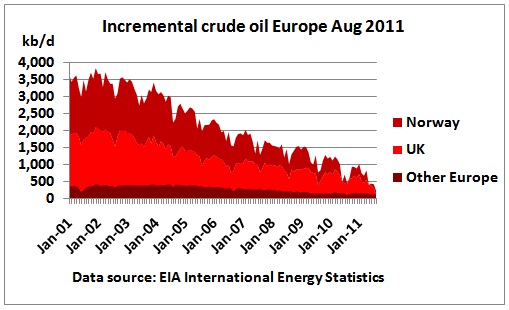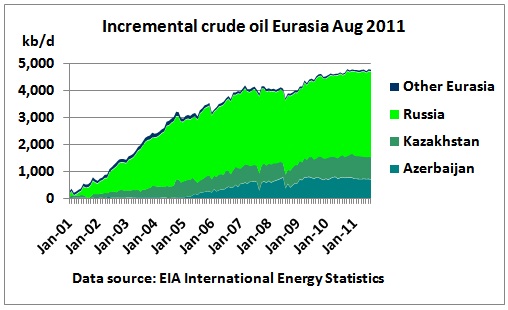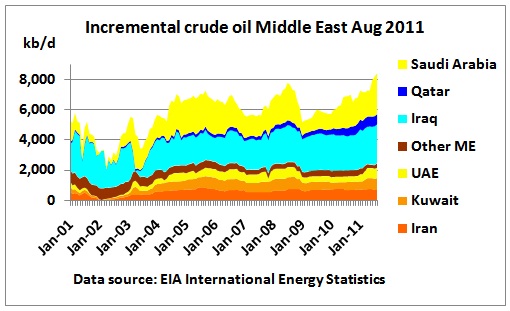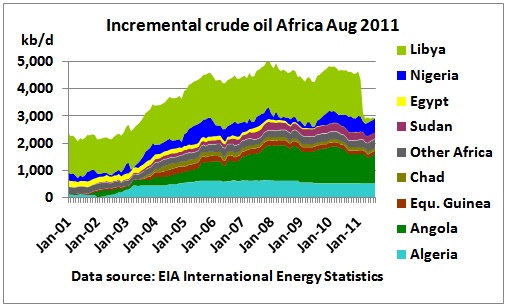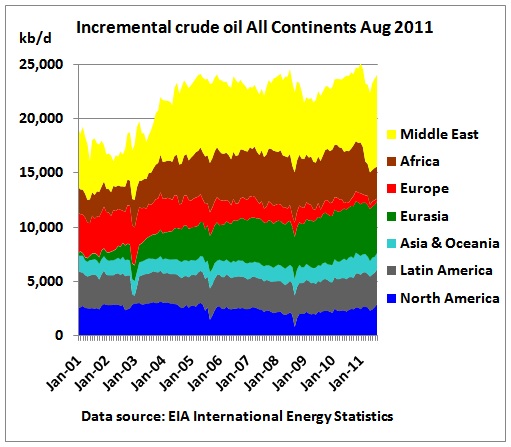(1) By continent
(1.1) North America
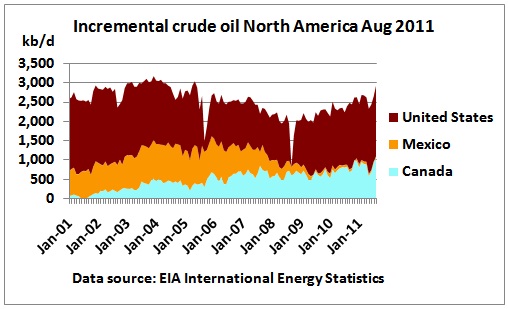 Growing Canadian production from tar sand syn crude could not offset Mexican decline. The US was able to increase production after the last hurricane and the Deepwater Horizon explosion. Total North American crude production in August 2011 was still 250 kb/d under the peak of 11,605 kb/d in December 2003 when Mexico peaked.
Growing Canadian production from tar sand syn crude could not offset Mexican decline. The US was able to increase production after the last hurricane and the Deepwater Horizon explosion. Total North American crude production in August 2011 was still 250 kb/d under the peak of 11,605 kb/d in December 2003 when Mexico peaked.
(1.2) Latin America
Growing Brazilian and Columbian oil production could not offset declining production in Venezuela and elsewhere. Crude production in August 2011 was still 160 kb/d lower than in Jan 2011.
(1.3) Europe
Europe is in full decline with seasonal fluctuations for maintenance of production platforms in the North Sea. Recently discovered oil off Norway’s coast (Aldous Major) may temporarily lift production in the 2nd half of the decade by maybe 500 kb/d which is equivalent to less than 2 years decline. Read here:
A Monster from the Deep
http://www.theoildrum.com/node/8746
(1.4) Eurasia
This area is growing. In 2008, the group seemed to remain on a plateau, suggesting a peak. But production increased again by around 750 kb/d, mainly from Russia. Azerbaijan and Kazakhstan’s combined production has been basically flat for the last 2 years.
(1.5) Middle East
The Middle East is basically on a very bumpy production plateau with Saudi Arabia still acting as a swing producer, although unable to control an upward trend in oil prices. We see serious decline in Saudi Arabia in 2006/07, followed by a production spike for the Olympic Games and then recovering to previous levels. Saudi Arabia’s most recent production spike only partially and belatedly offset Libyan production losses, suggesting the assumed spare capacity up to 12 mb/d is not there. Although growing, Iraq’s production in August 2011 was still 250 kb/d short of its pre-war peak of April 2001. Amazingly, Qatar has been increasing its production continuously over 6 years. It is to be noted that statistics do not seem to be very reliable. There are many months where production data remain unchanged, suggesting that either data are missing (data from previous month) or adjusted/embellished. Libya is a good example where statistics don’t show any change in production for 2 years (2009-2010).
(1.6) Africa
In incremental graphs those countries show up most which have seen large production changes during the observation period. Therefore, Libya now features prominently. Algeria is steady, Angola seemed to have had a peak and Nigeria fluctuates as usual. Egypt is in decline with dramatic socio-economic consequences. The rest of Africa is on a production plateau at around 300 kb/d.
(1.7) Asia and Oceania
Combined crude production from Australia, Indonesia and Malaysia have been in decline over the last decade. Only India and China increased production, “offsetting” decline elsewhere. However, few countries outside Chindia will have seen any net oil from these 2 countries appearing on oil markets. This causes the Tapis oil price to be above Brent.
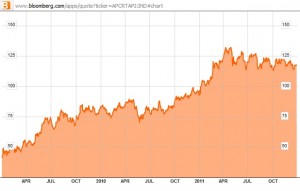 http://www.bloomberg.com/apps/quote?ticker=APCRTAPI:IND#chart
http://www.bloomberg.com/apps/quote?ticker=APCRTAPI:IND#chart
In August 2011, crude production in this region was just 50 kb/d higher than in Jan 2001. So much for the 1st decade of what is fanfared to be an “Asian century”. It gives us an idea what kind of fights over oil will emerge in the next 10 years.
(1.8) All continents/regions
(2) World
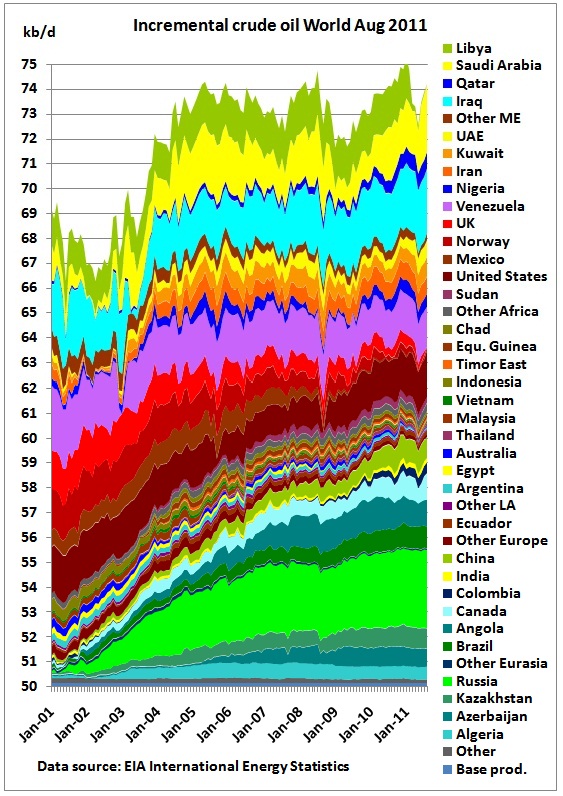 Base production is the sum of all minimum production levels achieved by each country in the period covered by the graph. Incremental production is then stacked in following order: growing production up to China (mainly green), then a myriad of smaller countries, most in decline, the US (recently recovered), Mexico and the North Sea declining (brown and red) and then on top OPEC and other ME countries. We see that the whole world up to “Other ME” has not been able to increase production since 2005 and that an extra of around 1.5 mb/ came from only 2 countries, Iraq and Qatar. We also see that the hitherto growing group has problems to grow at previous rates and that production growth has already stalled twice in the last 2 years. Without a 3 mb/d increase from Russia the world would have been in decline by that amount over the last 10 years.
Base production is the sum of all minimum production levels achieved by each country in the period covered by the graph. Incremental production is then stacked in following order: growing production up to China (mainly green), then a myriad of smaller countries, most in decline, the US (recently recovered), Mexico and the North Sea declining (brown and red) and then on top OPEC and other ME countries. We see that the whole world up to “Other ME” has not been able to increase production since 2005 and that an extra of around 1.5 mb/ came from only 2 countries, Iraq and Qatar. We also see that the hitherto growing group has problems to grow at previous rates and that production growth has already stalled twice in the last 2 years. Without a 3 mb/d increase from Russia the world would have been in decline by that amount over the last 10 years.

